The Egyptian Museum, Cario, Egypt
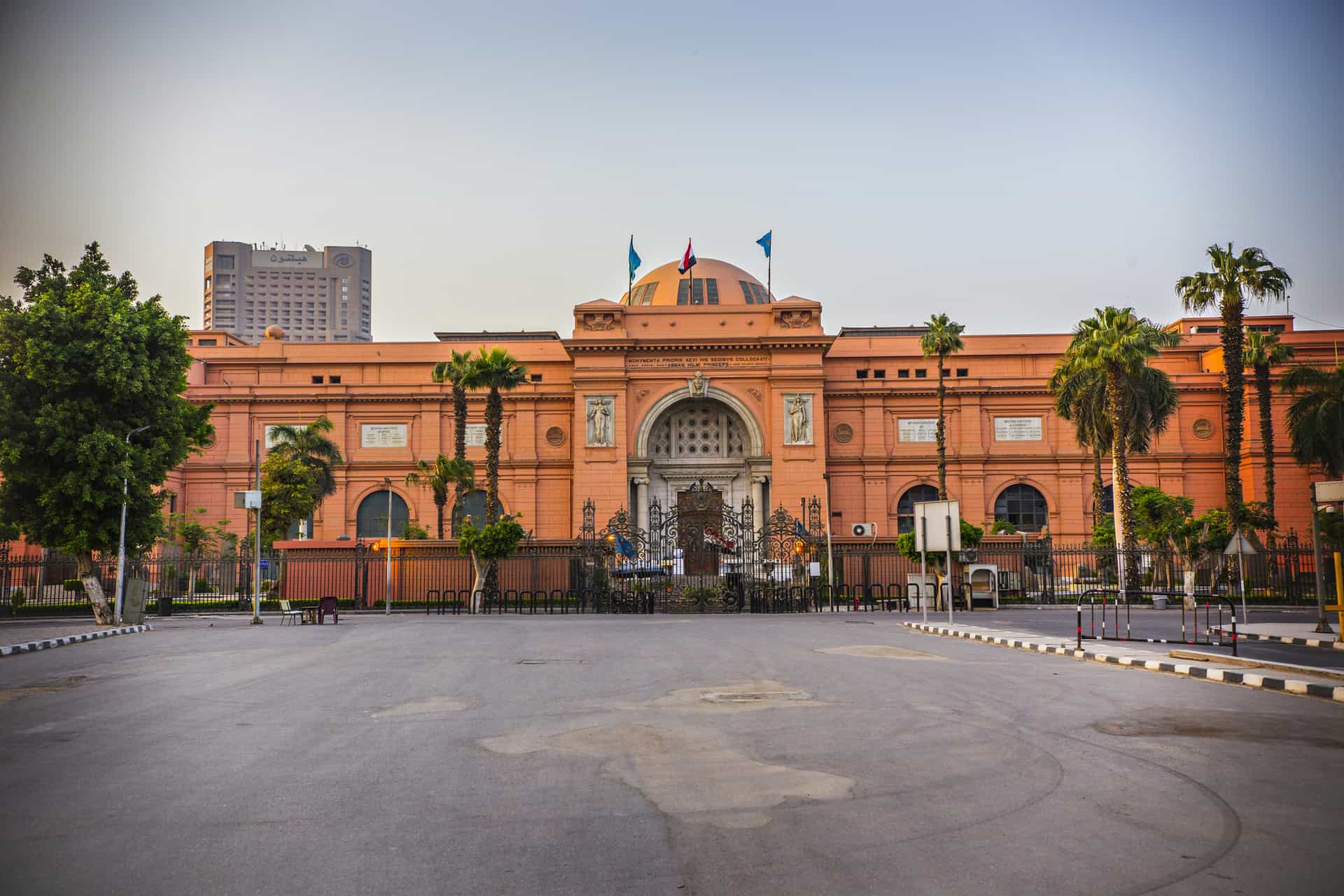
Updated On: April 15, 2024 by Yomna Salah
When you usually hear the word “Egypt”, the great ancient Egyptian civilization is probably the first thing that pops into your mind. Cairo, the capital of Egypt, is lucky enough to have a fair share of the ancient Egyptian monuments and remnants. Surprisingly enough, The Great Pyramids of Giza are not the only way to get to know the ancient Egyptian civilization. Cairo has another vital attraction, which is as important as The Great Pyramids. If you want an exciting experience of ancient Egypt in Cairo, The Egyptian Museum should be on your list. Established in 1835, The museum is home to more than 120,000 items and antiques of ancient Egypt. A visit to the museum is like a short journey in time, with a tour around the great God and Goddesses of ancient Egypt and hearing more about their stories.
History and Design of The Egyptian Museum
For those unaware, the Egyptian Museum in Cairo is home to the world’s most extensive Pharaonic monuments, some of which are the most significant antiquities of the ancient Egyptian civilization. This includes Tut Ankh Amon’s golden mask, for instance.
In 1835, the Egyptian Government established the first Museum close to Al Azbakeya Garden. Later on, the museum was moved to the Cairo Citadel. In 1858, a new museum was found in Boulaq in an ex-warehouse under the supervision of Auguste Mariette, the founder of the Antiquities Department in Egypt. As the construction was standing on the Nile Riverbank, it faced some struggles after a flood in 1878.
In 1891, the antiquities were moved to a new place (a previous imperial palace) in Giza and stayed there till 1902. In 1902, the museum was moved to its current place in Tahrir Square and has remained up till now. Furthermore, The construction of the Egyptian Museum in Tahrir Square was designed by the French architect Marcel Dourgnon and is known to be one of the most prominent museums in the region.
The museum has two floors (the ground and the first floor) and an outside garden. The ground floor has an immense assemblage of pieces of papyrus that belong to the ancient world. The writings on the papyrus include different languages, such as the Greek language, Latin language, and the ancient Egyptian language. Papyrus isn’t the only thing that’s exhibited on the ground floor. You can also find different Egyptian, Greek, Islamic and Roman coins there. The coins were made of various metals, including bronze, gold, and silver.
Moreover, different artefacts belonging to the New Kingdom are displayed, specifically from the time between 150 and 1069 BC. Those items are characterized by being more significant than the other artefacts which belong to previous times. The exhibits on the ground floor also include 42 rooms, coffins known as “sarcophagi, tables, and boats.
The second floor mainly houses artefacts from the last two dynasties of ancient Egypt. Those items include the tombs of many famous pharaohs, including Hatshepsut and Thutmosis III. It also hosts plenty of artefacts that belong to the Valley of the Kings. Tombs and monuments are not the only exciting things you will encounter while visiting the Egyptian Museum. Guess what? There are actually two rooms that accommodate a fair number of mummies! Those mummies are of kings and royal family members!
Interestingly, the garden near the building is considered as a memorial. It hosts statues dedicated to several of the world’s most important Egyptologists. The most important monument belongs to Auguste Mariette, the significant Egyptologist and the founder of the Egyptian Department of Antiquities. Auguste’s monument is enclosed by 23 busts of other Egyptologists, including the great Jean-François Champollion.
King Tutankhamun’s Death Mask
King Tut, Tutankhamun or Tutankhamen, is one of the most famous kings in the history of ancient Egypt (reigned from 1332 to 1323 BC). Interestingly enough, King Tut started his reign when he was nine years old! If you’re lucky enough to visit the Egyptian Museum in Cairo,, you’ll see Tutankhamon’s funerary mask, also known as King Tut’s death mask. According to English Egyptologist Nicholas Reeves, the mask is “perhaps the best-known object from ancient Egypt.
The Discovery of King Tut’s Mask
The burial chamber of King Tutankhamun was uncovered between 1922 and 1925 by Howard Carter – a British Archaeologist and Egyptologist – in the Valley of the King in Luxor (Thebes). The death mask of King Tut was one of many items found in his chamber. Howard Carter described the discovery of the mask in his diary, saying, “The mask has fallen slightly back, thus its gaze is straight up to the heavens.” The mask was then moved to the Egyptian Museum, where it’s being exhibited.
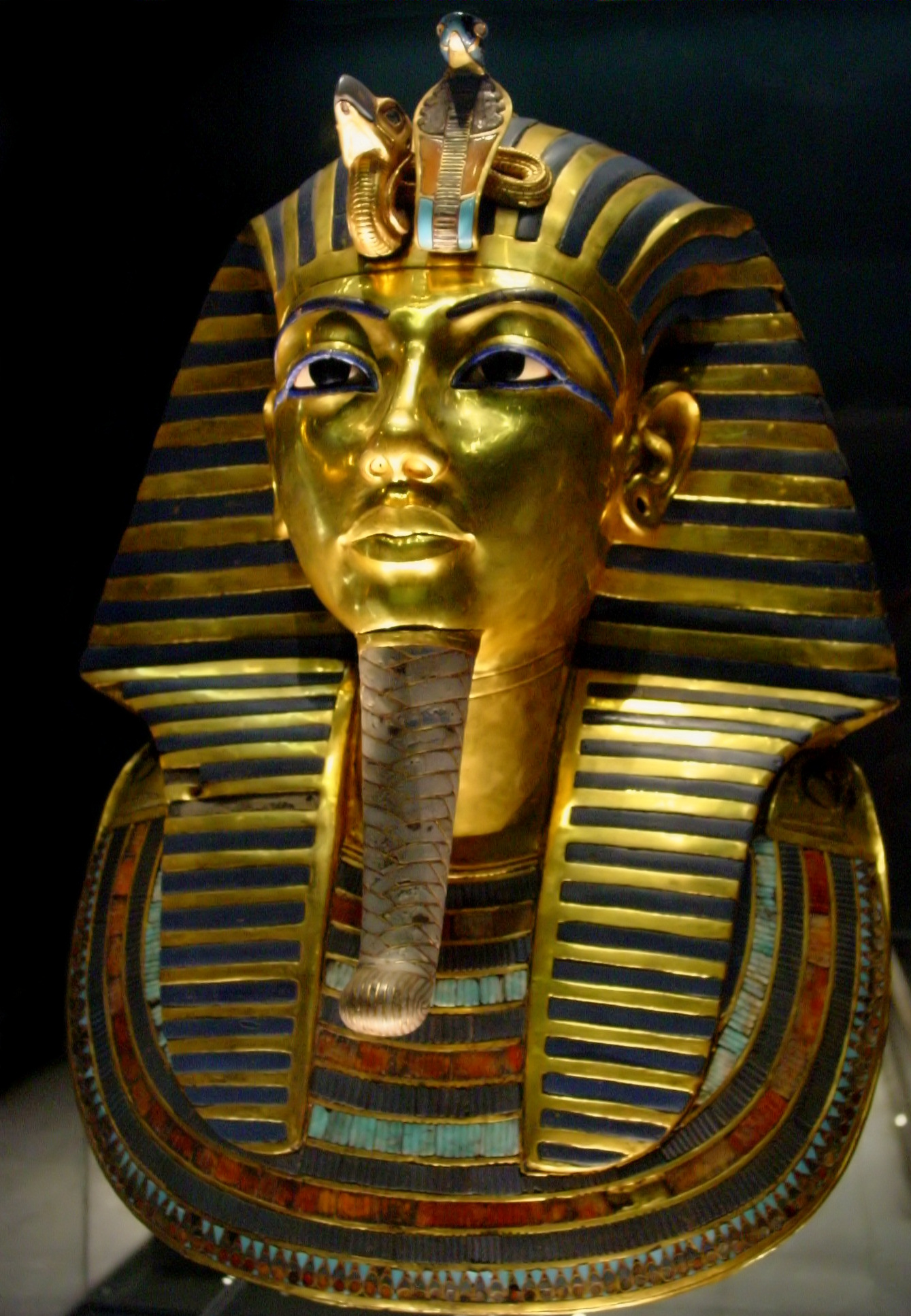
The Mask
It’s said that the mask is one of the most famous artworks in the world, and it is made of 11kg of pure solid gold. The mask represents the king’s known image. The Pharoah wears a striped nemes headcloth (commonly worn between Pharaohs in Ancient Egypt). On the top of the names, a cobra and a vulture, known as Wadjet and Nekhbet in the ancient language, were placed. The Cobra (Wadjet) represents Lower Egypt, and the Vulture (Nekhbet) represents Upper Egypt.
Rosetta Stone
This is the only piece in the museum that is not original, as the original piece is placed in the British Museum. So, the Rosetta Stone in the Egyptian Museum in Cairo is a Replica of the original one. Rosetta stone is a historic stone which helped the world know a lot about three thousand years of the ancient Egyptian heritage.
The stone has writings in Egyptian and Greek languages, and there are three types of writing: hieroglyphic, demonic, and Greek. The Rosetta was discovered during a Napoleonic war in Egypt by Pierre Bouchard, a French Captain.
The Hieroglyphic language was the language of religious writings and other important documents. The demotic language was known as the commonly used language in daily life. The Greek language was the language of the elites and the leaders of Egypt.
Moreover, the last part of Greek writing says that it is “written in sacred and native and Greek characters.” This helped the experts working on decoding the stone understand that the exact text was written in three different writing types, the hieroglyphic, the Demotic, and the Greek. The “sacred” language is referred to as the hieroglyphic, the “native” is referred to as the day-to-day Demotic language, and the “Greek” is the language used by the Egyptian leaders.
For how vital the stone is in helping the world know a lot about thousands of Egyptian civilizations, there has to be a piece in the Egyptian Museum, even if it is a replica. That’s the only unoriginal piece among more than 12,000 pieces in the museum.
Canopic Jars
Mummification was a widespread process in the ancient Egyptian culture and beliefs. It participated a lot in building the great civilization, still impressing the world. Ancient Egyptians believed in an afterlife, the soul and immortality. The human body is united with the soul in the afterlife, so mummification was a part of the whole process, as preserving their bodies was necessary for the other life.
Thus, working on developing funerary equipment and tools was important. Canopic jars were part of the funerary equipment and were used to hold the vital body organs as the body needed them in the reunion in the afterlife: liver, intestines, stomach, and lungs. As for the heart, ancient Egyptians believed the heart was where the soul stayed, so they did not remove it from the body.
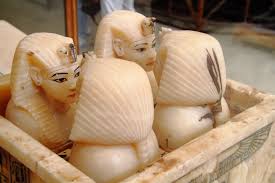
Canopic jars were usually made of limestone or pottery and were used in ancient Egypt from the Old Kingdom and moving to the Ptolemaic Period. The style of canopic jars varied over time. Interestingly, during the nineteenth dynasty, canopic jars were designed with lids portraying one of God Horus’s sons to protect the organs. You can find canopic jars as a part of the ancient Egyptian civilization in many museums worldwide, including the Egyptian Museum in Cairo.
Narmer Palette
This is the “first historical document in the world”! Narmer Palette, Palette of Narmer, or the Great Hierakonpolis Palette, is a very important Egyptian monument that dates back to the 31st century BC. The palette has some significant carvings and is the earliest ever found. The palette tells a story about a critical time in ancient Egyptian history. The carvings on the piece portray King Narmer’s famous unification of Upper and Lower Egypt.
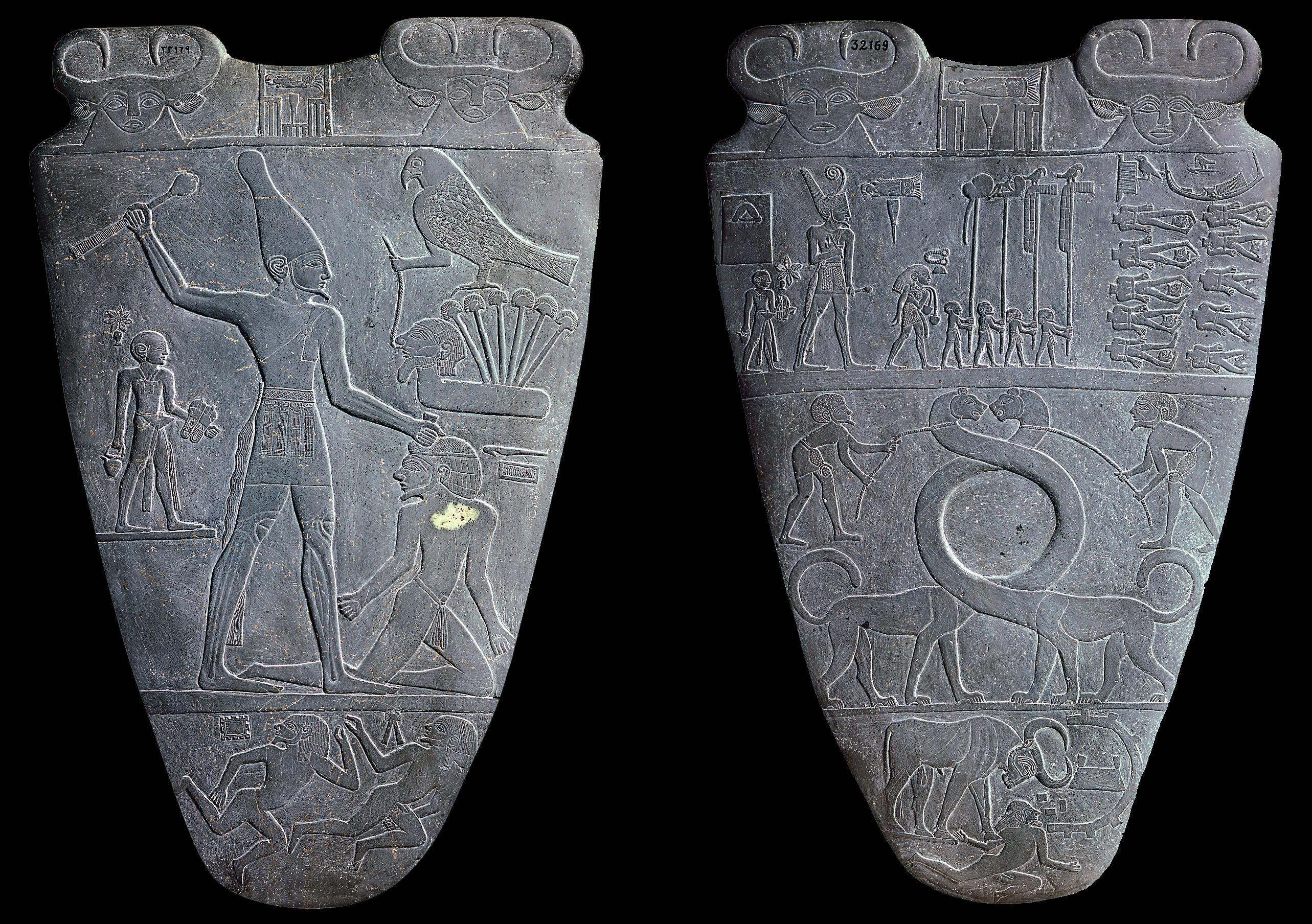
The palette has a political and martial message and is a bit explicit. Different carvings on the palette show the king’s continuous victory over his enemies. Some of the carvings on Narmer’s Palette portray holding a kneeling enemy and striking him. Other carvings show him stepping on other enemies’ bodies, and another one shows him destroying a city’s fortress.
Due to its significance, the Palette of Narmer is featured in different movies and literary works: For instance, it was featured in the film “Watchmen” in 2009, in a historical novel under the name “Pharaoh” in 2007, in a short story named “The Temple of El Alamein”, and in 2017’s Assassins Creed!
Queen Hatshepsut
Made of painted limestone, the head of Hatshepsut is one of the most famous pieces in the Egyptian Museum. The head was a part of Hatshepsut’s statue found at Al Deir Al-Bahari in Qena. Queen Hatshepsut is the fifth Pharaoh from the Eighteenth Dynasty, New Kingdom. According to many Egyptologists, Queen Hatshepsut is one of the most successful and significant rulers in the history of ancient Egypt. Most noteworthy, Queen Hatshepsut had the longest reigns between all the native women who ruled Egypt. Historians confirm that the Queen is the second female pharaoh in the history of ancient Egypt, considering her the “Foremost of Noble ladies.” Describing Queen Hatshepsut, Egyptologist James Henry Breasted said she is “the first great woman in the history of whom we are informed.
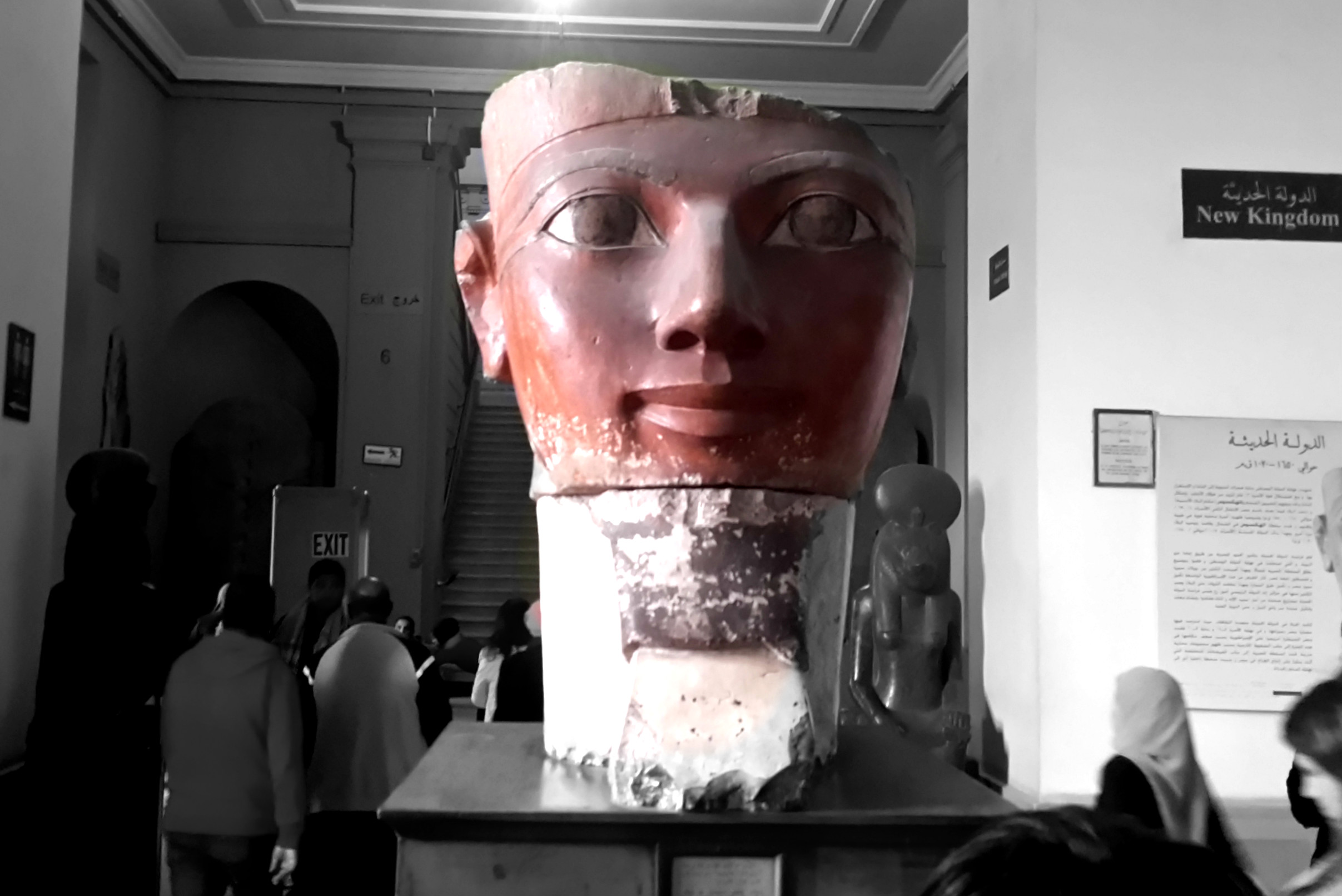
Let’s look closer at the head of Queen Hatshepsut standing in the Egyptian Museum in Cairo. The statue has thin eyebrows and beautifully drawn eyes, which give it a noticeable feminine look. The nose is hooked, and the mouth is very elegant, which shows how beautifully the queen was portrayed. Another impressive thing about the statue is its well-preserved colours, catching the eyes of whoever sees it.
Bust of Akhenaten
Akhenaten, Akhenaton, Khauenaten, Ikhnaton, and Echnaton all are names of the same great king who ruled Egypt for 17 years. Akhenaten was a king of the Eighteenth Dynasty. The king is one of the most important Pharaohs in the history of Egypt. History knows Ikhnaton as the king who deserted the common Egyptian polytheism (worshipping more than one God) and was the first to introduce monotheism (worshipping one God), worshipping the one God Aten. Iknaton’s wife is the famous queen Nefertiti. Nefertiti was known for supporting her husband in his religious revolution against polytheistic religions.
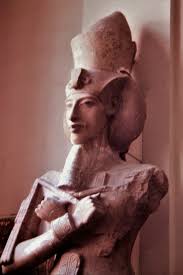
Located in the Egyptian Museum in Cairo, the remarkable Bust of Akhenaten was built in the Amarna style known in the eighteenth century. Amarna art is characterized by its lively spirit and touch of movement. Along with his wife Nefertiti, Pharaoh Ikhnaton’s time was one of the most privileged times in the history of Ancient Egypt.
Anubis, the God of Mummification
One of the most significant figures in Ancient Egyptian mythology, Anubis, was the God of mummification in Ancient Egypt known as “Lord of the Sacred Land” or “Lord of the Pure Land”. If you’re a fan of Ancient Egyptian mythology, then you know the story of Isis and Osiris. Anubis God’s role was to prepare the dead for God Osiris (the God of the afterlife and the underworld) to receive them. Interestingly, according to the myth, Anubis is the one who preserves Osiris after he is killed by Seth.
What does God Anubis look like?! Anubis was usually drawn as a man with the head of a jackal. As jackals were always seen in burial areas, Ancient Egyptians believed the God of mummification, Anubis, was looking for and preserving the dead.
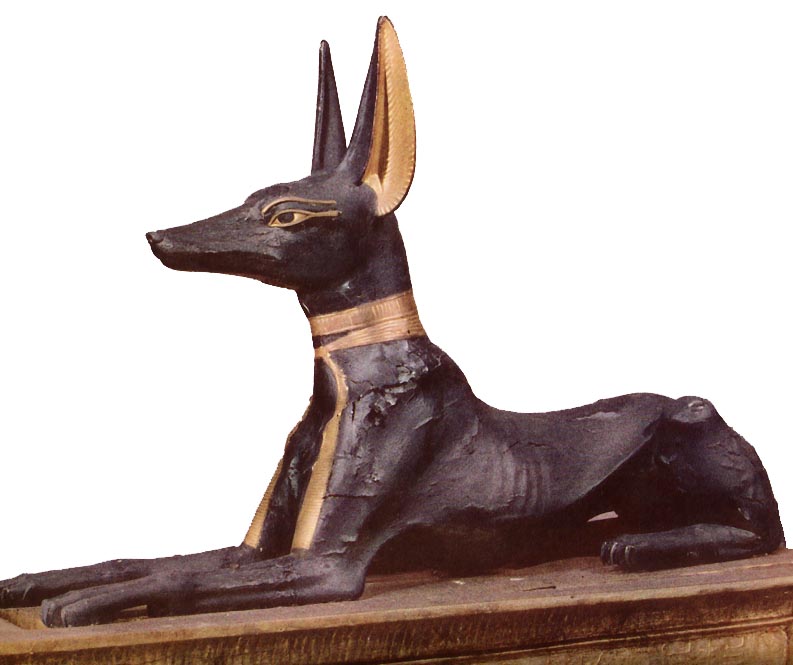
Located in the Egyptian Museum and considered one of the most essential pieces among the 12,000 items in the Egyptian Museum stands a beautiful statue of God Anubis, also known as Anubis Shrine. The shrine was found among the items of Tutankhamun’s grave. Though the statue was made of wood, it was beautifully formed, especially with the elegant black paint drawn on it. While finding your way around the stunning exhibits in the Egyptian Museum, you’ll discover the Anubis Shrine under the find number 261 in the museum.
As it’s found in Tutankhamun’s burial place, Anubis Shrine was used in the funerary and burial process of the king. It was explicitly located in front of the canopic chest in the Store Room of the cemetery. The statue was placed to look at the West as, according to ancient Egyptian beliefs, the West is the orientation of the afterlife.
“It is I who hinder the sand from choking the secret chamber and repel that one who would repel him with the desert flame. I have set aflame the desert (?); I have caused the path to be mistaken. I am for the protection of the deceased.” A magic spell? Very interesting, ha?!!
According to Howard Carter, this magic spell is written on a brick (known as ‘magic brick’) at the entrance of the storeroom in the burial chamber of King Tut. The magic spell is meant to protect the dead and preserve them. While planning your visit to the Egyptian Museum, Anubis Shrine should be among the exhibits, and you shouldn’t miss it there!
Merneptah Stele
The Victory Stele, Israel Stele, or Merneptah Stele is an essential biblical script engraved by Pharaoh Merneptah and dates back to the 19th dynasty. A part of its significance is that it has the earliest references to Israel, mainly saying, “Israel is laid waste, its seed is not.” and that’s why it’s called Israel Stele. Merneptah (from 1213 to 1203 B.C.) was the 4th ruler of the 19th dynasty and the son of the Great Pharaoh Ramesses II.
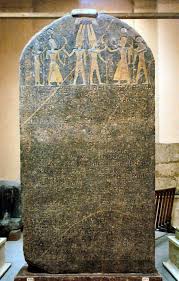
In 1896, The Stele was discovered by the British Egyptologist Flinders Petrie at Thebes (now known as Luxor). Merneptah Stele has engravings showing the martial triumphs of Merneptah in both Africa and the close Eastern regions. The Victory Stele is among the famous exhibits in the Egyptian Museum in Cairo.
Mummy mask of Wendjebauendjed
An ancient Egyptian general, a high priest, a Hereditary Prince and count, a King of Lower Egypt, a Seal-bearer, and a Priest of Osiris, lord of Mendes. Wendjebauendjed was an essential general from the age of Psusennes I in the 21 dynasty. Though little was known about Wendjebauendjed, he held many significant titles during his time. All the essential titles given to the general recognised him for being buried in royal cemeteries. However, he didn’t belong to the royal family. French Egyptologist Pierre Montent discovered Wendjebauendjed’s tomb inside a kingly necropolis in Tanis.
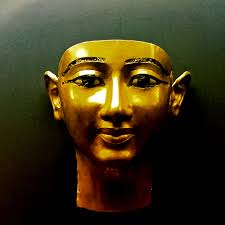
Colossal Statue of Amenhotep III and Tiye
is a monolith group statue of Egyptian pharaoh Amenhotep III of the eighteenth dynasty, his Great Royal Wife Tiye, and three of their daughters. It is the largest known dyad ever carved.[1] The statue originally stood in Medinet Habu, Western Thebes; today, it is the centrepiece of the main hall of the Egyptian Museum in Cairo.
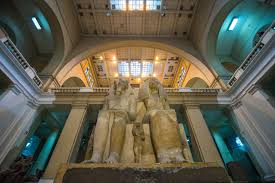
The statue is made of limestone, its width is 4,4 m, and its height is 7 m. The figures’ almond-shaped eyes and curved eyebrows are of typical late 18th dynasty style. Amenhotep III wears the nemes headdress with uraeus, a false beard and a kilt; he rests his hands on his knees. Queen Tiye is sitting on his left; her right arm is around her husband’s waist. Her height is equal to that of the pharaoh, which shows her prominent status. She wears an ankle-length, close-fitting dress and a heavy wig with a vulture headdress, modius and double uraei;[2][3] the cobras and the vulture are crowned, the proper correct cobra wears the white crown of Upper Egypt, while the proper left one wears the red crown of Lower Egypt.[4]
The statue is likely to have been carved around the first sed festival of Amenhotep III. Arielle Kozloff writes that the age of the daughters depicted on the monument, especially that of Henuttaneb, and the style of Queen Tiye’s wig, which was “at its most developed, nearly shrouding her face”, suggests that the statue was made during the third decade of the king’s reign. It is possible that it was made from the excellent quality limestone which was removed to create the open courtyard of TT192 – a massive tomb belonging to Queen Tiye’s steward Kheruef, work on which was started around this time.[6]
The royal couple’s eldest daughter, Sitamun, is absent from the statue group, probably because she was elevated to the rank of great royal wife by Year 30 of Amenhotep’s reign.
The statue belonged to the mortuary temple of Amenhotep III, which has been mostly destroyed since. Still, during its time, it was the largest temple complex in Thebes, surpassing even the Karnak temple. As it was built too close to the floodplain, less than two hundred years later, it already stood in ruins, and most of its stones were reused by later pharaohs for their building projects.
The Mummy Room
Yes! There is a whole room exhibiting mummies! Though visiting the Mummy Room will cost you an extra charge, the experience is very much worth it. That’s the best way to get as close as possible to the Ancient Egyptians’ greatness and meet them. Giving this room a fair share of your time at the Egyptian Museum is very recommended. The room has around 27 Mummies, which are surprisingly well-preserved. You’ll see natural hair, fingernails, and teeth in the Mummy Room among the displays.
All the above-listed pieces are nothing compared to what you can experience at the Egyptian Museum with all the artistic exhibitions and the giant statues. Visiting the museum is pretty much like a travel-around time of one of the most glittering times in the history of Egypt. However, you should organize your time there well. Imagine giving every piece of the 12,000 items a minute; that’d take months!! Organize your time, pick your tour guide, start your day early and be ready for one of the most stunning experiences in your life!






